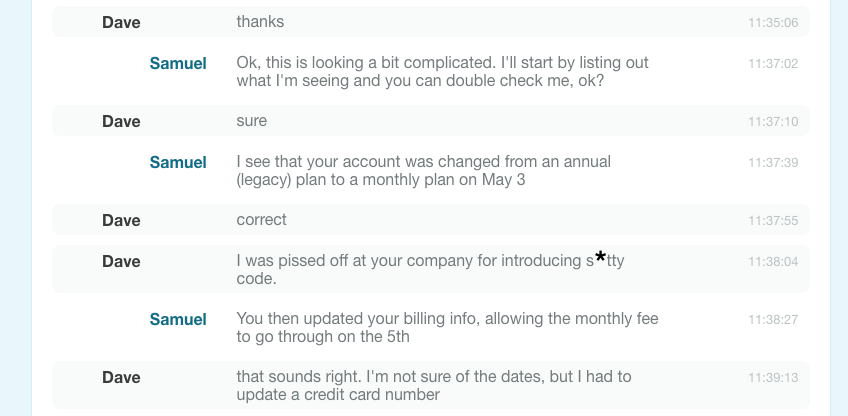An essential part of onboarding new customer support operators is teaching them the right way to talk to customers who aren't happy. Today Alex Ivanovs, of Stack Diary and business/startup columnist for Huffington Post, shares some of his tips for handling customer complaints.
Difficult customers are part of the business process. Nobody likes dealing with them, but often we have to. It's best to be prepared for these situations - like when a customer is typing in ALL CAPS - as some customers might take it a little bit too far.
In this age of social media and global interconnectedness, customer complaints can sometimes gather momentum before we even realize there's a problem. Customers, like us, can quickly amplify their voices — and sometimes that results in things getting uncomfortable.
The best way to handle unhappy customers is by establishing a customer complaints strategy that can be applied immediately after a complaint is received. In this post, I'll outline a few key elements to include in your strategy.

Understanding the type of customer and complaint
"It’s impossible to build on the belief that our users are always right and that we should listen to them. Because if we do, we’re like a wheel in the sky that may keep on turning but also changes direction based on the opinions of other people." - Stefan Rössler
Each customer complaint is unique, but the attitude of the complaining customer can usually be bucketed into one of four major categories. That's not to say that you should assume you know everything about the customer based on the tone of their complaint — you definitely don't! — but quickly categorizing the customer's attitude can help you understand and empathize with their position.
 (A sample customer conversation where the customer is, um, not happy with something you did.)
(A sample customer conversation where the customer is, um, not happy with something you did.)
Here are the most common customer complaint attitudes:
- Casual -- The casual customer doesn't care much. They want their problem solved...but they don't really expect to get what they want. By investing in getting to the bottom of their complaint, you can show them that even though they might not be taking the issue seriously, your company does. Helping a casual complainer can be a great opportunity to outperform expectations and win loyalty.
- Aggressive -- Aggressive customers are just that — aggressive. They may also be confused, frustrated, or even deeply angry. Whatever you do, don't stoke the fire by responding to these customers with similar aggression. Instead, take a deep breath and offer a sincere, measured response. You want the customer to know that you're listening, but also that you deserve their respect.
- Curious -- These customers are never satisfied with standard features or support responses. They're constantly looking for ways to dig into the "guts" of your product, learn how it ticks, and customize it to fit their use case; they're probably also constantly suggesting updates and improvements. It pays to listen to these customers carefully, even if their questions and ideas don't always seem relevant. Chances are, their questions and ideas will ultimately help you make your product better.
- Entitled -- Entitled customers believe that you owe them a custom solution, or some other form of special treatment. They might be your top revenue-generators...or they might never have actually bought anything from your website. Although you will sometimes have to make exceptions for bigger accounts, the best way to handle entitled customers is to apply consistent procedures and standards. It may not make everyone happy in the moment, but it will demonstrate that you're committed to treating everyone fairly.
Keeping it strictly business
 Customer complaints can sting — it's completely normal for a tirade against your company or support team to feel deeply personal. But one of the most valuable skills you can learn as a customer service agent is simply taking a deep breath and letting a complaint go. Let the customer say everything they have to say, allow the complaint to unfold, and do your best to empathize with the fact that they're only trying to get help.The fact that a customer is unhappy with a particular feature or aspect of your product doesn't mean you've done something wrong.
Customer complaints can sting — it's completely normal for a tirade against your company or support team to feel deeply personal. But one of the most valuable skills you can learn as a customer service agent is simply taking a deep breath and letting a complaint go. Let the customer say everything they have to say, allow the complaint to unfold, and do your best to empathize with the fact that they're only trying to get help.The fact that a customer is unhappy with a particular feature or aspect of your product doesn't mean you've done something wrong.
De-escalating the exchange
If a customer comes in 'hot', it's always a good idea to start with a friendly salutation. Sometimes a simple, "Hello!" can help drop a customer out of the red zone. It gives them a sense of being listened to, and in many cases that's all you need to get things back on the right track.
But if things don't de-escalate after your first friendly pass, you still have lots of tools available to help you gain control of the situation. Here are just a few:
- Questions -- Dig deeper to understand the customer's problem. When did it start? What was the motive? What does the customer want to achieve? The more you understand about the problem, the easier it will be to solve it.
- Empathy -- Put yourself in the customer's shoes. They're frustrated, upset...maybe even a little bit scared that the problem they experienced is going to have a major impact on their business or personal life. Affirm what they're feeling ("I completely understand that this is frustrating"), and try to find common ground so you can open better lines of communication.
- Sincerity -- A sincere apology will often completely defuse a negative or emotional exchange. Try a simple,'I am sorry that you had to experience that.' The more real you can be, the more you come off as an actual human, which helps the customer empathize with your position.
- Solution -- One of the best ways to help your customers in tough situations is to ask them what they think the solution should be. Then, you can work together to either implement their solution, or to come up with a good middle ground.
Following up
Even if you think you've resolved a complaint to the customer's satisfaction, a quick followup after a few days is always a good idea. If nothing else, it will help clear the air.
All you need to do is send a quick email, like this one:
Hi Mark,
Hope all is well.
Please let me know if you're still experiencing problems with [the problem]. I'm more than happy to help you out if you're still having troubles.
Let me know if you have any other questions, I'm here to help. Have a great day!
Kind regards,
Alex
You can adjust the email to reflect your own feelings and style of writing — the key is to make your customer feel valued, and to communicate your gratitude for their patience and understanding.
Reviewing the situation
Once the dust has settled on a particularly difficult customer conversation, it's a good idea to review your chat transcripts to see if you can identify when and why the exchange become heated. You can also have a colleague review your chat transcripts to get an objective take on the situation. You might ask questions such as:
- Was the issue actually resolved? Did the customer actually have a question, and did I answer it? Maybe there was some heat in the conversation, but did the substance lead to the customer getting what they needed?
- Was either party provoked? Was there something in particular that the customer said, or that I said, that set the conversation down a negative track? If you can pinpoint a turning point, you can be on the lookout for similar situations and defuse them more quickly in the future.
- What next steps should we take? Aside from a friendly followup email, are there other actions that need to happen? Should your social media team be on the lookout for this customer venting publicly? If so, be sure the entire team has the full details on the situation so they can respond in a fast, human way if needed.
- What did we do right? Pat yourself and your teammates on the back for anything positive that came out of the complaint. Did the customer get their issue resolved, even if the path to a solution was a little rough? Did your team identify an opportunity for process improvement, catch and correct an error, or develop a better understanding of your product that will allow you to help future customers more quickly? Customer complaints are tough, and one way or another, you're on the other side of this one — so take a moment to celebrate!

